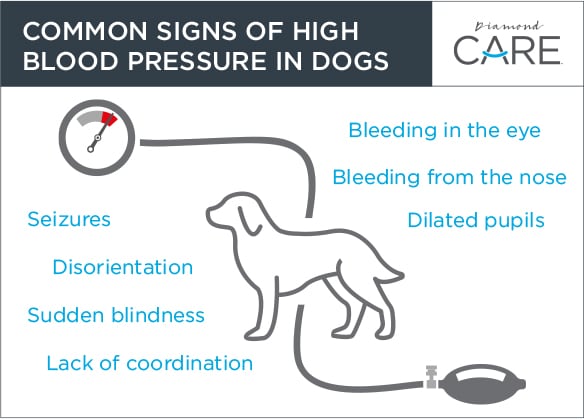Symptoms of hypertension in dogs include seizures. Disorientation. Blindness. weakness. Heart murmur. nosebleed. More commonly called hypertension than systemic hypertension in dogs Hypertension occurs when the arterial blood pressure in dogs is continuously higher than normal. When it is caused by another illness, it is called secondary hypertension. Primary hypertension, on the other hand, is when you are actually ill. Dogs with high blood pressure should have their blood pressure checked by a veterinarian every few months. Your veterinarian may recommend one or more medications to dilate blood vessels (lower your pet's blood pressure) or to treat the underlying condition that causes high blood pressure. Dogs exhibit many symptoms that are reflected in low blood pressure, such as decreased activity. And weaker than his usual self. Also, dogs can faint or suddenly collapse at any time, so you need to keep your eyes sharp and be careful when that happens. His or her gums, like any other mucous membrane, will be pale, pale pink or white. Hypertension in dogs, scientifically known as arterial hypertension, indicates an increase in arterial blood pressure during diastole. If the result of the arterial blood pressure test is above 170-180 mm Hg, the dog will have high blood pressure, but the diastolic blood pressure should be above 110 mm Hg.
The following are just a few of the more common symptoms exhibited by hypertensive dogs: stroke circulation and / and diversion blindness, dilated pupil or retinal detachment, hematuria of the eye. Hematuria in blood or urine Bleeding from the nose Swollen or contracted kidney Heart tweet Weakness, involuntary vibration of one side of the body or leg eyeball (rolling) Palpable thyroid (in the case of hypertension)
What does it mean if your dog has hypertension?
If your pet has high blood pressure, it means that the blood vessels are too narrow to handle high pressure blood. A useful analogy is the garden hose connected to a fire hydrant. The high pressure from the hydrant can cause the hose to contract and pop out.
When do you take your dog to a vet with high blood pressure?
As a precautionary measure, most dogs over the age of 7 are screened for hypertension at an annual screening. However, if you notice that your dog has one of the following, it may be a sign of high blood pressure and should be taken to your vet immediately.
What are the symptoms of hypotension in dogs?
The symptoms of hypotension are: 1 lethargy 2 weakness 3 fainting or collapse 4 pale or white gums 5 confusion 6 excessive weeping 7 increased thirst.
What is considered to be high diastolic pressure in dogs?
The diastolic pressure should not exceed 100-110. Anything higher than that is considered high. High blood pressure in dogs is diagnosed by measuring blood pressure with a cuff similar to that used to measure blood pressure in children.
How do I know if my dog has high blood pressure?
Drinking and urination increased with the progression of chronic kidney disease. Blood in the urine (called hematuria) is bleeding in the nose or passages of the nose (known as nosebleed or nosebleed) Heart tweets or abnormal heart rhythms.
What are the early warning signs of high blood pressure?
If your blood pressure is very high, you should be aware of certain symptoms such as: Severe headache. nosebleed. Fatigue or confusion. Visually impaired. Chest pain. Dyspnea. Irregular heartbeat. Blood in the urine. Hypertension Symptoms-Hypertension-WebMD
What can dog hypertension cause?
& gt;Signs and symptoms of hypertension in dogs Blindness, dilated pupils or retinal detachment, eye bleeding. Blood in urine or protein in urine. Bleeding from the nose. Swelling or contraction of the kidney.

Below you will find two helpful answers on a similar topic. 👇
What are 5 simple facts about living with blindness?What are 5 interesting facts about sponges?
